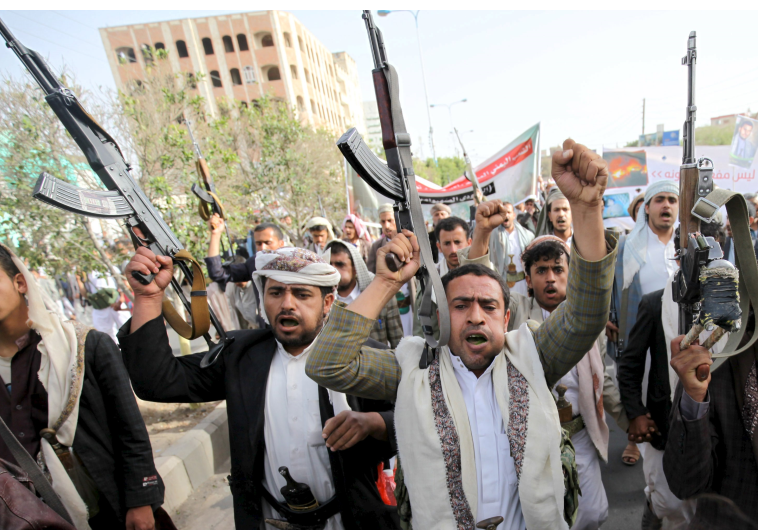
The axes of Yemen’s war
Abdulrahman al-Rashed/Al Arabiya
Thursday, 7 May 2015
The Yemeni crisis involves several parties, but the major axes are the forces of isolated former President Ali Abdullah Saleh and the Houthis on one hand, and the Yemeni government – which now resides outside the country – and the Saudi-led alliance on the other. There is also Al-Qaeda. Given these axes, the war may go on for months, perhaps years, unless the capabilities of Saleh and the Houthis are diminished. This must not only be done via military confrontation, but also by attracting most of the military and tribal powers, which Saleh dominated, to the government’s side. The most important aspect of the war is not its intensity, but the disintegration of Yemeni domestic partisan and tribal alliances. The war is no longer limited to the capitals Sanaa and Aden, as there is now fighting in 10 of Yemen’s 21 governorates – half the country. In addition, the Houthis have opened a front against Saudi Arabia by shelling the latter’s border cities. This was expected from the start, as it is a tool of social and propaganda pressure against the kingdom.
Escalating the situation
Meanwhile, the Iranians and their allies are trying to escalate the situation via the media by intensifying coverage of events to the extent that the war has become the most covered affair. They think Yemen will be the swamp that will keep Saudi Arabia busy in relation to other hotspots in the Middle East. There are also unremitting attempts to support the “Saleh-Houthi” camp by sending weapons and experienced fighters. These attempts, however, have so far failed due to the naval and aerial embargo.
The dispute can end either via a clear victory, which is almost impossible due to the presence of several parties, or by achieving enough victories to convince the opposing forces to negotiate. The latter is actually the major aim of the battle. The other scenario is for the war to last until all parties are exhausted but still maintain their gains, similar to Afghanistan. The Houthi attack on border posts and their shelling of neighboring cities will not achieve the expanded invasion that they threaten. Geography is a major obstacle throughout the long border between the two countries, and the Houthis do not have the capability to fight and march for long northward toward southern Saudi Arabia.
Igniting fires
However, they can continue to ignite fires by shelling across the border and obstructing civilian life in neighboring Saudi areas. This, however, will not alter the political path of the battle.
The most important aspect of the war is not its intensity, but the disintegration of Yemeni domestic partisan and tribal alliances. There are efforts to convince the various tribes to break their alliance with Saleh and the Houthis and join the legitimate government, which is the guarantee to Yemen’s unity and independence.
محاور حرب اليمن الأربعة
عبد الرحمن الراشد/الشرق الأوسط/07 أيار/15
في الحقيقة توجد أطراف عدة في الأزمة اليمنية، إلا أن محاورها الرئيسية تتمثل في جماعة الرئيس المعزول علي عبد الله صالح والحوثيين من جهة، والحكومة اليمنية التي أصبحت تقيم في الخارج من جهة ثانية، مع قوات التحالف بقيادة المملكة العربية السعودية، وهناك تنظيم القاعدة. وبسبب تعدد المحاور، قد تطول الحرب إلى أشهر وربما إلى ما وراء ذلك، ما لم يتم تقليص قدرات صالح والحوثيين، ليس من خلال المواجهة العسكرية فقط، بل كذلك باجتذاب معظم هذه القوى العسكرية والقبلية التي هيمن عليها صالح إلى صف الحكومة. الحرب أصبحت واسعة ولم تعد مقتصرة على العاصمتين صنعاء وعدن، بل صارت القوى الأربع تتقاتل الآن في عشر محافظات يمنية، أي نصف البلاد المقسمة إلى إحدى وعشرين محافظة. إضافة إليها، وسع الحوثيون المعركة بفتح جبهة قتال ضد السعودية، بقصفهم مدنها الحدودية، وهو أمر كان منتظرًا منذ البداية، كوسيلة ضغط اجتماعية ودعائية ضد المملكة.
خارج اليمن، يحاول الإيرانيون وحلفاؤهم رفع درجة الحرارة إعلاميا، من خلال تكثيف التغطية، حتى أصبحت الحرب اليمنية الشأن الأوسع تغطية، معتقدين أن اليمن سيكون مستنقع السعودية الذي سيشغلها عنهم في المناطق الساخنة الأخرى في الشرق الأوسط، إضافة إلى محاولات حثيثة من أجل دعم معسكر «صالح – الحوثي» بإدخال الأسلحة والمقاتلين الأكثر خبرة إلى مناطق الاقتتال، وهي المحاولات التي باءت بالفشل حتى الآن، بسبب الحظر البحري والجوي.
أما كيف يمكن إنهاء النزاع، فيتم إما بالنصر المبين، وهذا يكاد يكون مستحيلاً في ظل وجود قوى متعددة، أو من خلال تحقيق انتصارات كافية لإقناع الأطراف المعارضة بالجلوس إلى الطاولة والتفاوض، وهو الهدف الأساسي من المعركة، أو أن تستمر الحرب طويلاً حتى تتعب الأطراف المختلفة ويحافظ كل فريق على مكاسبه، أي النموذج الأفغاني.
ماذا عن تهديدات الحوثيين باكتساح جنوب السعودية، التي رافقت صور البيوت المحروقة في مدينة نجران؟ هجمات الحوثيين على مراكز حدودية، وقصفهم المدن المجاورة، لن يحقق لهم الاجتياح الواسع الذي يهددون به. نجران مدينة ملاصقة تمامًا للحدود مع اليمن، وكذلك مدينة جيزان الملاصقة بحريًا. فالجغرافيا هنا مانع أساسي في كثير من الحدود الطويلة بين البلدين، ولا يملك الحوثيون القدرة على القتال والعبور طويلاً شمالاً، لكنهم يستطيعون الاستمرار في إشعال الحرائق بالقصف عبر الحدود وتعطيل الحياة المدنية في المناطق المجاورة لهم إلى حين، ولن يغير هذا مسار المعركة سياسيًا. والأهم في المعركة اليمنية ليست القذائف والرصاص، بل أهم من كثافة النيران، تفكيك التحالفات اليمنية القبلية والحزبية الداخلية. وهناك جهد كبير لإقناع القبائل المختلفة بالانفضاض عن صالح والحوثيين والانضمام إلى الحكومة الشرعية التي هي ضمانة وحدة اليمن واستقلاله.




















